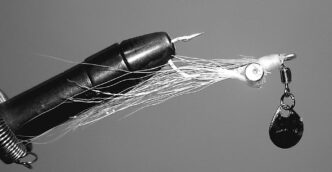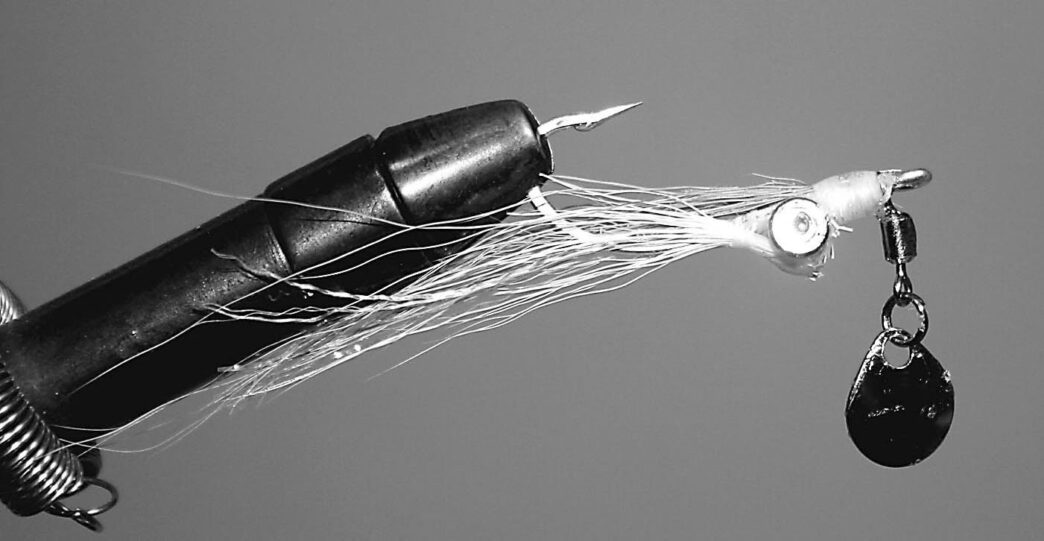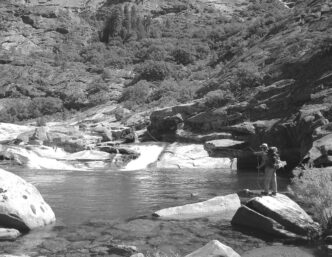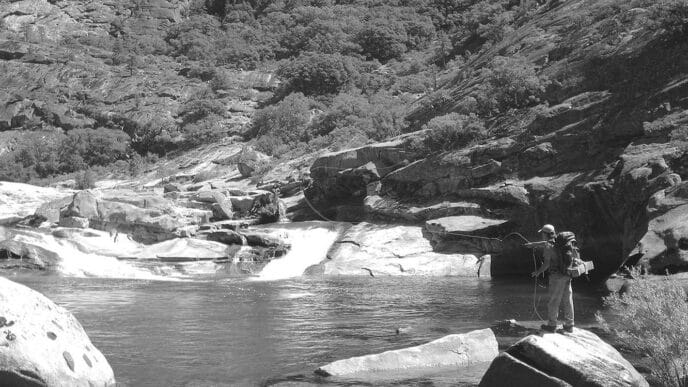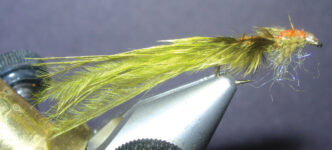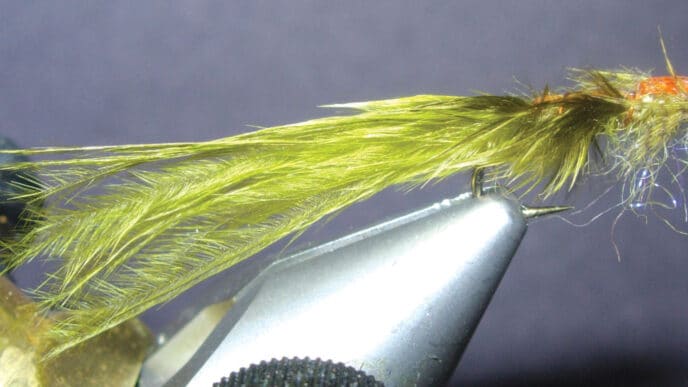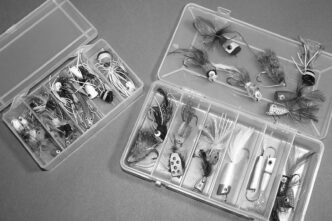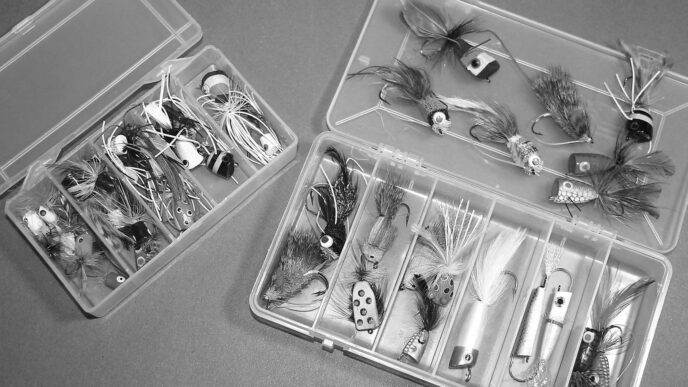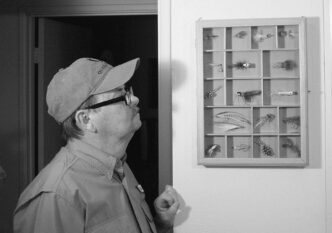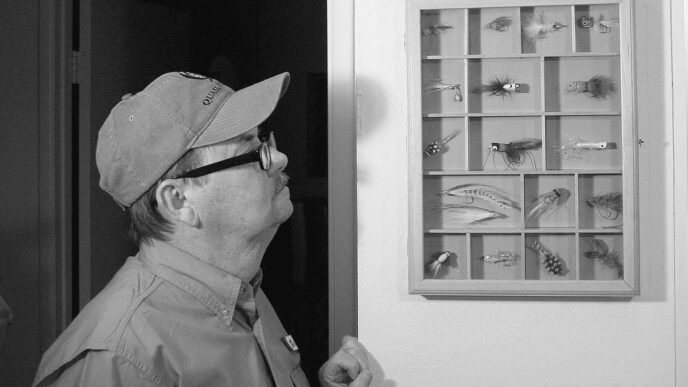Now that the spring bass spawn is well and truly behind us, bass fishing settles into a summer pattern, and so, too, should the bass fly angler. The spawn meant that you could target bass right near the shore and in shallow water, but now they might be almost anywhere along a series of depths ranging from a few inches of water that will barely cover their backs to deep sanctuaries where the biggest fish loaf away the middle of each hot summer day.
It’s the old real estate slogan: “Location, location, location,” applied to bass angling. Where they are at any given moment is based on water temperature, light level, and the activity going on over their heads. So to find them, it helps to review a few bass-fishing fundamentals. Bass, like trout, are creatures of habit, and they tend to perform the same basic movements over and over, unless weather or water conditions change. It’s just that their habits are different enough from those of trout in a stream to require a change in approach when fishing for them. Follow their pattern, and you’ll find and catch bass.
At the dawn of a warm, nearly windless summer day, as the sky lightens, you’ll find that most bass are in the shallows, particularly in those areas that are still the most shaded. They’ve been there most of the night. They’ve moved up to seek baitfish that hug the weed beds, reeds, and other aquatic plants that grow in the shallows. This is one of my favorite times to be on the water. Because the mature bass are there to hunt the bait, instead of feeding on aquatic insects, the best fishing will be when the water is dark, but the sky is light enough to frame a baitfish against a brighter background when viewed from below.
Take a closer look at the position of the eyes on a bass. Like most larger predator fish, their eyes are located closer to the top of the head, so they can look up with ease. This is a primary stalking tactic — to position themselves nearer the bottom and stare up with those lidless eyes to detect smaller prey above them. They are camouflaged and are hard to see looking down into the darker bottom below, but the bait they chase have sharp silhouettes framed against a bright background sky.
The reason that early morning is one of my favorite times to be on the water is that it’s a time to fish top-water flies. Surface fishing with bass bugs is the best of bass fishing with a fly rod. It’s akin to casting a dry fly for trout, and because the strike is so visible, it’s just plain fun. Depending on a lot of things, from the steepness of the shore, to the presence of structure such as weed beds or overhead cover such as lily pads, to the topography of any hills to the east, you may have as little as 15 minutes of good top-water fishing or more than an hour of this magic time each morning. The other factor that makes early morning bass fishing so good is the general lack of disturbance both to the water and to your peace of mind while fishing.
The wind is generally at its lowest ebb in the morning — a little riffle on the water is good, because it breaks up the brightening light of day and delays the departure of the bass for deeper water — and as yet, the water skiers and the personal watercraft crowd haven’t yet showed up to roil the surface and make noise that sends the bass packing for their deep-water haunts and anglers muttering angrily to themselves. A subtle breeze that comes and goes is ideal in the half-light of predawn.
Sometimes you get a flat, glassy calm that makes the presentation more technical. This is the time and place for casting a smaller and lighter bug. Put that fat cork popper built on a 2/0 hook away and switch to a hair bug tied on a size 2 or size 4 hook. I’m probably going to get in trouble for saying this, but color matters less than many bass anglers might think. For the most part, the bass are going to see only the outline of the bug on the surface. Likewise, the eyes, flash, and most of the other things we like in a well-crafted bass bug simply aren’t necessary. The action you impart to the bug is a lot more important than any of that. I went through a stage where I thought that the only good color for a bass bug was yellow. It worked, too. Then I became enamored of black bugs in low light and red-and-white for the bright hours. These worked, as well. Actually, they all worked. That’s the point.
Because bass hold near structure, your presentation should be aimed at some object that would attract bass. In shallow, near-shore water, most bass-holding structure is pretty obvious. Drop the bug near stands of tules or reeds, openings in weed beds, or around vertical objects such as dock pilings and especially overhead cover such as docks, boats, or other floating stuff that provides a dark place for a bass to lurk. If the bug is weedless, try tossing it up on the solid overhead cover and pulling it slowly off so that it drops straight down onto the water like some unfortunate critter that made a mistake.
The state of the surface will in large part dictate the movement of the bug after the cast. When the water is calm, you should be, too. Put the bug on the surface with as little fuss as you can, then just let it lie still for as long as you can. Often a bass will move up close, where it can inspect the bug. Then, if the bug doesn’t do anything threatening, the bass will attack. This waiting game can be nerve-racking, particularly when you can see the bass as it lurks beneath the bug trying to decide whether or not to eat it.
The better your casting accuracy is, the better your chances of hooking a sizeable bass. Casting within inches to structure is always better than landing your bug feet away from it. Bass bugs don’t cast as well as dry flies, and a weight-forward line designed to cast them will help, as will getting close to your target. This isn’t “fine and far off ” fishing. A cast of 40 feet is more common in bass fishing than a cast of 60 feet — and a lot easier to make.
When the surface is riffled by wind or the beginnings of the morning boat traffic, you can add a bit of action to the surface fly you are fishing. Aggressive pops of a bug send sound and vibration into the water, alerting bass that something is there that just might be food. You can make more of a ruckus and get smashing strikes where half an hour earlier, the mere twitch of a bug was enough to get the attention of a bass, and the take was often a gentle slurp not all that different from a trout sipping a helpless dry fly off the surface. With a bit of chop on the water, the bass get more aggressive, and the take gets rougher, because the bass doesn’t want the food to get away. Skittering a bass bug quickly over rippled water gets exciting! I don’t know if it is the muscular build of a bass or that huge mouth that makes a strike into an explosion, but whatever it is, I like it.
As the sun rises higher in the sky, the bass will retreat into ever darker water. This could mean a simple horizontal movement back into cover along the shore — and there will always be some bass that refuse to go very far, simply melting into the weed beds or tules in quite shallow water and staying there, provided they have concealment. However, usually they move back into deeper water and slowly away from the shore. If you are fishing from a boat or float tube and have a depth finder, it’s pretty easy to track where the fish are moving. You can follow the contours of the submerged structure and keep in contact with the fish as they swim deeper.
If you don’t have a depth finder, take a look around at the shore and the submerged structure you can see. Points and channels, old streambeds, and natural lines of timber or other structure that run to the water probably continue right under the surface for some distance. Bass use these natural edges to move to and from deep water to shallow water and back again. A submerged stream channel is a sort of bass superhighway. Being familiar with the area you are fishing is important. Knowledge of the contours of the bottom is as helpful as being a competent caster.
This is when you want to switch to something that dives or sinks so you can get it down to where the bass are heading. A diving fly like one of Larry Dahlberg’s designs is often a good fly for fishing the first full hour of daylight. The diving action gets the fly down where the bass can see it, and the slow rising action of the fly when you stop the retrieve often draws a strong strike. Other good flies for this intermediate-depth fishing include ordinary streamers, lightly weighted Clouser Minnows, and the like.
In slightly discolored or stained water, I like to employ a spinner/fly combination that creates a bit of flash and sound to go with a minnowlike shape gliding at depths of four to eight feet. The one I use most often these days is a thing called the Coyote — a streamer fly with a single Colorado-style spinner blade suspended under the chin of the streamer. It creates just the right amount of sparkle and noise to draw bass out of the shadows to attack.
From midmorning until near sunset, with the shadows gone and strong light penetrating well into the depths, the bass will have retreated to much deeper water for the most part. I know — the last time you went fishing, you caught a huge bass at noon in two feet of water. I’ll bet that bass came out from under something that provided both shade and overhead protection from predators. It is true that some bass will stay shallow, but they will seek a place of cover that’s as shady as they can get, and they won’t venture out except to strike at a passing baitfish.
Most of the larger fish will have retreated into the depths. This is when you break out the sinking lines and fish down 10 feet or more. At one lake I used to fish, there were two or three old, broken-down trees on a sloping point that ran out from a weedy shore area, and that spot was always good early in the morning. I could almost always count on finding a few fish lurking in the limbs of the shallowest tree an hour after sunrise. An hour later, they were either hugging the trunk at the bottom of this tree or they had moved down the slope into deeper water and were hanging around the middle tree. At noon, if you could buy a strike at all, it came out of the lower branches of the third tree, in about 15 feet of water.
Daytime is also when you should trade your bass bugs and streamers for slinky, bottom-bouncing flies that work much like a plastic worm. This isn’t as much fun as fishing the upper inch of the lake, but it can provide the best fishing you will get all day in terms of the size of the bass you can hook. In a long career of flyfishing for bass, I’ve caught a couple of big bass. One came right at the surface and the other in more than 10 feet of water. I’d be hard-pressed to say which was the most fun.
All this, of course, happens in reverse when you approach the later afternoon hours of a long summer day. As the shadows lengthen and the light begins to wane, the bass that spent most of the day in deeper water or hidden in cover will begin to move up and into shallow, more open water to seek smaller fish for an evening meal. You have to adjust what you are doing with fly patterns and presentation to get them to react.
Never forget for a moment that bass are as predatory in their environment as a mountain lion stalking a deer along the shaded edges of a clearing. In fact, good deer hunters often grasp the essentials of hunting for bass before the average fly angler does. They are used to expecting deer to leave their cool, leafy haunts and move out into more open country to feed when the light levels are low. Anglers who are used to fishing trout streams, on the other hand, are prone to think that the best time for fish activity is when the sun gets on the water and warms it, setting off the daily cycle of insect hatches. Insects may hatch in warming still waters, too, and the little fish that eat insects may react to this by feeding, but the bigger predators that eat the little fish are waiting for the low light levels of early morning and evening to do their hunting. In the middle of the day, angling slows down, but that’s mostly an illusion caused by both the bait and the bass moving into deeper water. If you think “Location, location, location” and adjust your fly-fishing tactics accordingly, you’ll catch more bass.



